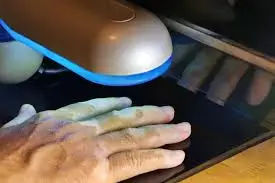- Home
- Medical news & Guidelines
- Anesthesiology
- Cardiology and CTVS
- Critical Care
- Dentistry
- Dermatology
- Diabetes and Endocrinology
- ENT
- Gastroenterology
- Medicine
- Nephrology
- Neurology
- Obstretics-Gynaecology
- Oncology
- Ophthalmology
- Orthopaedics
- Pediatrics-Neonatology
- Psychiatry
- Pulmonology
- Radiology
- Surgery
- Urology
- Laboratory Medicine
- Diet
- Nursing
- Paramedical
- Physiotherapy
- Health news
- Fact Check
- Bone Health Fact Check
- Brain Health Fact Check
- Cancer Related Fact Check
- Child Care Fact Check
- Dental and oral health fact check
- Diabetes and metabolic health fact check
- Diet and Nutrition Fact Check
- Eye and ENT Care Fact Check
- Fitness fact check
- Gut health fact check
- Heart health fact check
- Kidney health fact check
- Medical education fact check
- Men's health fact check
- Respiratory fact check
- Skin and hair care fact check
- Vaccine and Immunization fact check
- Women's health fact check
- AYUSH
- State News
- Andaman and Nicobar Islands
- Andhra Pradesh
- Arunachal Pradesh
- Assam
- Bihar
- Chandigarh
- Chattisgarh
- Dadra and Nagar Haveli
- Daman and Diu
- Delhi
- Goa
- Gujarat
- Haryana
- Himachal Pradesh
- Jammu & Kashmir
- Jharkhand
- Karnataka
- Kerala
- Ladakh
- Lakshadweep
- Madhya Pradesh
- Maharashtra
- Manipur
- Meghalaya
- Mizoram
- Nagaland
- Odisha
- Puducherry
- Punjab
- Rajasthan
- Sikkim
- Tamil Nadu
- Telangana
- Tripura
- Uttar Pradesh
- Uttrakhand
- West Bengal
- Medical Education
- Industry
Handheld Narrowband UVB Device Therapy Effective and Safe for Vitiligo Treatment, suggests study

Handheld Narrowband UVB Device Therapy Effective and Safe for Vitiligo Treatment, suggests a study published in the Indian Journal of Dermatology, Venereology and Leprology.
Handheld narrowband ultraviolet B (NB-UVB) device is a portable, home-based, patient-friendly equipment used in vitiligo. It is a newer promising treatment that lacks generalised consensus due to heterogenicity among studies.
A study was done to determine the clinical efficacy and safety profile of handheld NB-UVB devices in the treatment of vitiligo. Following the PRISMA guidelines and using appropriate keywords, the Embase, PubMed and Scopus databases were searched on 28 November 2023. Data on the proportion of patients with a percentage of re-pigmentation and toxicity were extracted from the included studies. Random effects and fixed model were utilised to generate pooled estimates via meta-analysis. Results: Out of 250 articles, 13 studies (557 patients) were included.
The extent of repigmentation achieved over a median duration of 6 months (range 3-12 months) was quantified to be > 25%, > 50%, and >75 % in 63.6% (95% CI: 51.0–75.3%), 40.8% (95% CI: 30.4–51.6%) and 15.4% (95% CI: 7.6–25.3%) of patients respectively. After 12 weeks of treatment, the proportions of patients achieving > 25%, > 50%, and >75% re-pigmentation were 31.1% (95% CI: 9.6–58.3%), 12.9% (95% CI: 3.1–28.1%) and 6.5% (95% CI: 1.7–14.1%), respectively. Similarly, at 24 weeks, these proportions were 53.2% (95% CI: 24.5–80.7%), 36.7% (95% CI: 15.8–60.5%), and 11.1% (95% CI: 2.9–23.7%). Minimal erythema dose (MED) calculation-based therapy was not significantly better than therapy given without MED calculation (p = 0.43).
The studies with only stable vitiligo patients did not achieve significantly greater > 25% (p = 0.06), > 50% (p = 0.80), and > 75% (p = 0.25) re-pigmentation compared to the studies that also included active or slowly progressive vitiligo. Three sessions per week resulted in significantly higher > 50% (p < 0.01) and > 75% (p = 0.01) re-pigmentation. Totally, 11.3% (38/334) of patients showed no response to therapy.
The most commonly reported adverse event was erythema in 33.4% (95% CI: 19.3–49.2%) of patients, with grade 3 and 4 erythema in 27 and 15 patients, respectively. Other adverse events included pruritus, burning, hyperpigmentation, dryness, and blister formation observed in 22.1%, 16.4%, 19.1%, 9.8%, and 9.7% of patients, respectively. Handheld NB-UVB portable home-based devices are an efficacious and safe treatment option in vitiligo patients even without MED calculation, when the treatment frequency is three to four sessions per week.
Reference:
Khandpur S, Singh S, Paul D. Clinical efficacy and safety profile of handheld narrow band ultraviolet B device therapy in vitiligo – Systematic review and meta-analysis. Indian J Dermatol Venereol Leprol. doi: 10.25259/IJDVL_71_2024
Dr. Shravani Dali has completed her BDS from Pravara institute of medical sciences, loni. Following which she extensively worked in the healthcare sector for 2+ years. She has been actively involved in writing blogs in field of health and wellness. Currently she is pursuing her Masters of public health-health administration from Tata institute of social sciences. She can be contacted at editorial@medicaldialogues.in.
Dr Kamal Kant Kohli-MBBS, DTCD- a chest specialist with more than 30 years of practice and a flair for writing clinical articles, Dr Kamal Kant Kohli joined Medical Dialogues as a Chief Editor of Medical News. Besides writing articles, as an editor, he proofreads and verifies all the medical content published on Medical Dialogues including those coming from journals, studies,medical conferences,guidelines etc. Email: drkohli@medicaldialogues.in. Contact no. 011-43720751


